E.G. Wolverson's Blog
September 29, 2025
Gig Review | Oasis: Live ’25 at Wembley Stadium, 28th September 2025
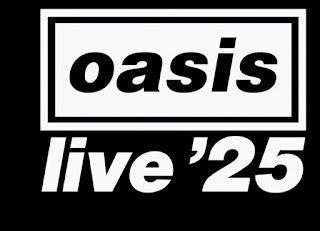 After losing an entire Saturday trying to get to tickets to the first batch of live dates that Oasis announced, I’m hesitant to say that I was fortunate enough to be able to get tickets to the last of Wembley dates added onto the Live ’25 tour – those tickets felt bloody hard-earned in the end. Yet, having been successful in a ballot in which so many others were not, and having secured tickets at a pre-set fixed price, rather than the dynamically-priced rip-offs of that much-maligned Saturday, some degree of luck certainly came into it - or perhaps it was fate. Walking into that gig with the lad – now a grown-up CEO and justice of the peace to boot – with whom I used to critique Oasis lyrics in the mid-90s, it felt like we were always meant to be here now.
After losing an entire Saturday trying to get to tickets to the first batch of live dates that Oasis announced, I’m hesitant to say that I was fortunate enough to be able to get tickets to the last of Wembley dates added onto the Live ’25 tour – those tickets felt bloody hard-earned in the end. Yet, having been successful in a ballot in which so many others were not, and having secured tickets at a pre-set fixed price, rather than the dynamically-priced rip-offs of that much-maligned Saturday, some degree of luck certainly came into it - or perhaps it was fate. Walking into that gig with the lad – now a grown-up CEO and justice of the peace to boot – with whom I used to critique Oasis lyrics in the mid-90s, it felt like we were always meant to be here now. For me, the approach to Wembley was unique as it was the first time that I’d been there for anything other than a football match. Having grown accustomed to the partisan banter between rival supporters, there was something liberating about attending an event where everyone was on the same page; everyone was celebrating. Even the losers.
And the event hadn’t even begun yet.

Rather than watch Cast warm-up the crowd, we were drawn into the Fan Zone by the sounds of the Killers and James, whose songs had been appropriated by the MiddleTones - a perfectly selected tribute band who had us singing along raucously long before the brothers Gallagher had taken to the stage inside. That’s really quite an achievement given how much punters were being charged for cans of Stella poured into plastic cups. It’s a wonder anyone at all was even remotely pissed at those prices.

On the concourse, we listened to Richard Ashcroft belt out many of the Verve’s signature tunes as we suffered the traditional Wembley wait for wees. How a football stadium could be constructed with so few urinals and so many male cubicles is beyond me. My wife and daughters berate me whenever I bemoan the dearth of urinals in modern buildings because they take the firm view that as they have to queue for the loo, so should I, whereas I hold the trenchant opinion that there’s no fucking need for a man to queue for the loo as we don’t need to sit down for a piss, and nobody poos in stadiums. We just need a massive trough to urinate in. You should be able to unzip as you’re walking in, zip up as you’re walking out. Even with a capacity crowd there should never be a need to queue for more than about thirty seconds.

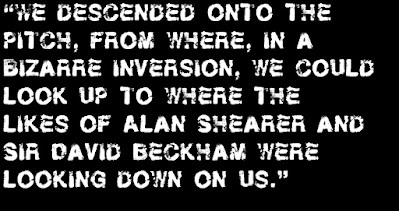 As we weren’t tempted to partake in the customary Wembley cuisine – as ever it’s chicken and chips, or falafel and chips for veggies – we entered the arena just as the screens lit up and “Fuckin’ in the Bushes” assaulted our eardrums. Sipping Stella from a half-empty plastic cup with one hand and spilling it clumsily from a full plastic cup in the other, we descended onto the pitch, from where, in a bizarre inversion, we could look up to where the likes of Alan Shearer and Sir David Beckham were looking down on us. Just a few metres forward of the front-row seats that my daughter and I occupied for a recent Women’s FA Cup Final, my friend and I were engulfed by a euphoric mass of humanity who cumulatively belted out “Hello” at such a decibel level that I don’t think I heard a single word that left Liam Gallagher’s gob.
As we weren’t tempted to partake in the customary Wembley cuisine – as ever it’s chicken and chips, or falafel and chips for veggies – we entered the arena just as the screens lit up and “Fuckin’ in the Bushes” assaulted our eardrums. Sipping Stella from a half-empty plastic cup with one hand and spilling it clumsily from a full plastic cup in the other, we descended onto the pitch, from where, in a bizarre inversion, we could look up to where the likes of Alan Shearer and Sir David Beckham were looking down on us. Just a few metres forward of the front-row seats that my daughter and I occupied for a recent Women’s FA Cup Final, my friend and I were engulfed by a euphoric mass of humanity who cumulatively belted out “Hello” at such a decibel level that I don’t think I heard a single word that left Liam Gallagher’s gob. 
The next few tracks were a blur of jumping around with strangers who knew every word of every song irrespective of whether it first appeared on the sixteen-platinum (What’s the Story) Morning Glory? or one of its gem-laden singles. Why I ever got rid of those cigarette packet-style CD single box sets I once had is beyond me now; they’d probably be worth a fortune. Rock classic “Acquiesce” encapsulated not only the grudgingly acknowledged symbiosis of the Gallagher brothers, but their relationship with their audience, and even the audience’s own relationships with each other. I certainly had my old friend from 1995 well and truly back, belting out “Morning Glory” and “Some Might Say” to those watching from the seats above us with much more fervour than the deliberately cool Liam Gallagher.

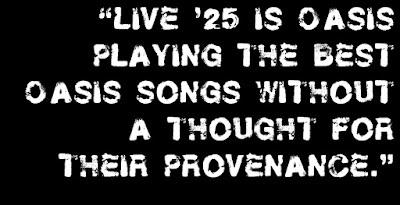 Now I’ve seen many a Britpop-era band play live – Radiohead, Suede, and the Manics to name a few – but what really set this gig apart for me was its superlative setlist. Everybody knows that touring bands generally have an agenda to promote new material, even if that new material is a label-selected Greatest Hits compilation, but Live ’25 truly breaks the mould in that it isn’t a band plugging a new album and just dutifully peppering in a few classics, nor is it a band laboriously working through all their mainstream chart hits. Live ’25 is Oasis playing the best Oasis songs without a thought for their provenance. Most of the tracks are either lifted directly from Definitely Maybe or (What’s the Story) Morning Glory?, or have been taken from singles of the same era, whereas Be Here Now and Heathen Chemistry are given representation proportionate to the patchy quality of those albums, and everything else is - quite rightly - ignored altogether (unless you count “Fuckin’ in the Bushes”, which I don’t. It’s just noise).
Now I’ve seen many a Britpop-era band play live – Radiohead, Suede, and the Manics to name a few – but what really set this gig apart for me was its superlative setlist. Everybody knows that touring bands generally have an agenda to promote new material, even if that new material is a label-selected Greatest Hits compilation, but Live ’25 truly breaks the mould in that it isn’t a band plugging a new album and just dutifully peppering in a few classics, nor is it a band laboriously working through all their mainstream chart hits. Live ’25 is Oasis playing the best Oasis songs without a thought for their provenance. Most of the tracks are either lifted directly from Definitely Maybe or (What’s the Story) Morning Glory?, or have been taken from singles of the same era, whereas Be Here Now and Heathen Chemistry are given representation proportionate to the patchy quality of those albums, and everything else is - quite rightly - ignored altogether (unless you count “Fuckin’ in the Bushes”, which I don’t. It’s just noise).
Of course, there were still quibbles. Most attendees I spoke – well, slurred - to lamented the omission of the iconic “Columbia”, particularly when its obvious slot was instead taken up by the little-known B-side “Fade Away”, which marked not only the first of my friend’s many toilet breaks but a decided lull in the atmosphere. Even this track, though, clearly had special resonance for the recently reconciled brothers as the giant screens that flanked them displayed a collage of childhood photographs, perhaps allowing them to break through the boarded-up doors that had separated them for so many years.

After the aggressive tumult of “Bring it on Down”, “Cigarettes & Alcohol”, “Supersonic” and “Roll with It” left us scratching our heads over Liam’s aberrantly conventional pronunciation of sunshine, imagination and all the many other -tions (maybe that James Buckley parody got under his skin...), Noel Gallagher took centre stage to deliver an emotional “Talk Tonight” followed by the uplifting brace of “Half the World Away” and “Little by Little”. “The Importance of Being Idle” would have slotted into this section perfectly, if I were to nitpick, but leaving Liam idle for three tracks was already pushing Noel’s luck.

 As a spectacular light and sound show heralded the start of “D’You Know What I Mean?”, I lamented the state of my cardio fitness levels as once more, the whole crowd on the pitch seemed to conjoin into one bouncing, triumphant mass that continued right through the anthemic “Stand By Me”. Thankfully the lower key, but utterly beautiful, “Cast No Shadow”, offered me a brief reprise from all the jumping up and down. When my friend snuck off to the loo again (I warned him not to break the seal), I took the opportunity to spin around and take in the full extent of the euphoria around me. Ninety thousand people. Most seemingly my age or thereabouts, but many younger too. Some my age but weighed down by clearly a teenage child in an Oasis tee. About seven over fifty. Adidas everywhere.
As a spectacular light and sound show heralded the start of “D’You Know What I Mean?”, I lamented the state of my cardio fitness levels as once more, the whole crowd on the pitch seemed to conjoin into one bouncing, triumphant mass that continued right through the anthemic “Stand By Me”. Thankfully the lower key, but utterly beautiful, “Cast No Shadow”, offered me a brief reprise from all the jumping up and down. When my friend snuck off to the loo again (I warned him not to break the seal), I took the opportunity to spin around and take in the full extent of the euphoria around me. Ninety thousand people. Most seemingly my age or thereabouts, but many younger too. Some my age but weighed down by clearly a teenage child in an Oasis tee. About seven over fifty. Adidas everywhere. 
Returning from the loo with more Stella in hand, my friend joined me to sway through “Slide Away” and “Whatever”, before asking me to show him the setlist playlist on my Spotify again so he could see what was coming next. He was not to be disappointed. Has there ever been a stronger finish to a set than an emotional “Live Forever”, delivered against a giant backdrop of the late, great Ricky “the Hitman” Hatton, followed in short order by an explosive “Rock ‘n’ Roll Star”? I doubt it. But it was the encore that would have lifted the roof, had Wembley’s designers deigned to add one.

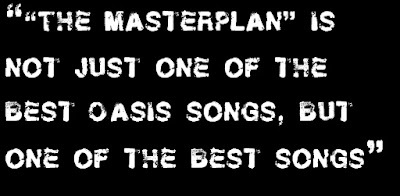 “The Masterplan” is not just one of the best Oasis songs, but one of the best songs (I’d say period, but I’m not American, so I’ll just add what we Brits call a full stop to the right of these parenthesis). To think that I discovered it hidden away on the “Wonderwall” CD single is, from today’s viewpoint, both unbelievably wasteful and somehow quite romantic. I remember being really annoyed when it became the title track of the eponymous Masterplan compilation album a few years later because it didn’t feel like mine anymore. I really miss those days of unearthing a secret masterpiece; telling all your mates about it; seeing it quietly gain traction. On this night though, I was more than happy to share it.
“The Masterplan” is not just one of the best Oasis songs, but one of the best songs (I’d say period, but I’m not American, so I’ll just add what we Brits call a full stop to the right of these parenthesis). To think that I discovered it hidden away on the “Wonderwall” CD single is, from today’s viewpoint, both unbelievably wasteful and somehow quite romantic. I remember being really annoyed when it became the title track of the eponymous Masterplan compilation album a few years later because it didn’t feel like mine anymore. I really miss those days of unearthing a secret masterpiece; telling all your mates about it; seeing it quietly gain traction. On this night though, I was more than happy to share it. 
“Don’t Look Back in Anger” followed, and it was nothing short of joyous. There’s no better anthem. “Wonderwall”, whilst a bit overrated in my view, is every bit as iconic, and I’ve never enjoyed it more than I did alongside ninety thousand fellow devotees, singing rather crying their hearts out while covered in spilt lager and all desperate for a wee. Thankfully the days of “I am the Walrus” closing out Oasis gigs have long since gone, and it was with the peerlessly poignant “Champagne Supernova” that Liam serenaded the UK crowd for the last time on this tour.

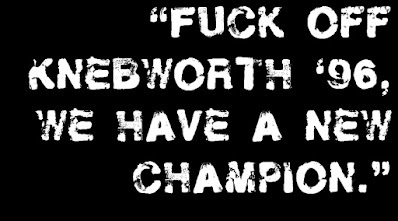 I wasn’t sure whether the signs around the venue advising that the show was being filmed was meant to be a warning to behave, or an incitement not to, but despite past form Oasis have now gone the whole UK tour without the Gallagher brothers throwing so much as a plum at each other, and if Liam’s only real comment of the evening is to be believed, then this tour will not be their last. If they do return, I sincerely hope that it will be with the same sort of show as Live ’25. The cynic in me suspects a new album might follow instead, though, and, if it does, Live ’25 may prove to be the sweetest of sweet spots to have finally seen Oasis live.
I wasn’t sure whether the signs around the venue advising that the show was being filmed was meant to be a warning to behave, or an incitement not to, but despite past form Oasis have now gone the whole UK tour without the Gallagher brothers throwing so much as a plum at each other, and if Liam’s only real comment of the evening is to be believed, then this tour will not be their last. If they do return, I sincerely hope that it will be with the same sort of show as Live ’25. The cynic in me suspects a new album might follow instead, though, and, if it does, Live ’25 may prove to be the sweetest of sweet spots to have finally seen Oasis live.
I’ll never see the Beatles. I’ll never see Nirvana. And if I ever see the likes of Bob Dylan or Pink Floyd, it’ll probably be shit because they won’t play half the stuff that I want them too. This, though, was damn near perfection - very probably the best setlist that there has ever been in the history of musical performances, delivered with calm dynamism to the most appreciative of crowds. Fuck off Knebworth ’96, we have a new champion.
December 12, 2023
TV Review | Doctor Who: “The Giggle” by Russell T Davies
 Despite William Hartnell going missing for half of it and three-quarters of it being missing from the BBC’s archives,
The Celestial Toymaker
remains one of the first Doctor’s best remembered stories. In years to come, I dare say the same will be true of the Toymaker’s second coming and David Tennant’s second going, “The Giggle”.
Despite William Hartnell going missing for half of it and three-quarters of it being missing from the BBC’s archives,
The Celestial Toymaker
remains one of the first Doctor’s best remembered stories. In years to come, I dare say the same will be true of the Toymaker’s second coming and David Tennant’s second going, “The Giggle”. Of course, The Celestial Toymaker’s fame is as much down to infamy as affection. Brian Hayles’ scripts were rewritten several times by several people as the serial found its budget slashed. One of its characters proved to be so “Bunteresque” that the BBC had to air a disclaimer to avoid a potential copyright lawsuit, and, more importantly, great swathes of the audience struggled with the whimsical fantasy of the piece. Since then, changing times have made the Toymaker as played by Michael Gough ( Batman ) a divisive figure. Despite Gough’s Toymaker having enough beguiling charisma to carry almost an entire episode of the serial acting against nothing but a disembodied hand, his sartorial style wreaks havoc with current sensibilities. What in 1966 was simply an exotic-looking mandarin costume is today, to some, cultural appropriation. There has even been concern that the word “celestial”, clearly and obviously a reference to the Toymaker’s outer-space godliness, could be taken to be a veiled reference to Chinese emigrants to the West.


Given all this baggage, Russell T Davies’ take on the classic monochrome villain has to be regarded as one of his most inspired reimaginings to date. Rather than run from the quagmire of potentially audience-offending issues, Davies’ script embraces them, actively exaggerating the Toymaker’s theatrical insensitivities and even having him display overt signs of racism. The fact that he has the power of a god and is still petty enough to make racist remarks to Charles Banerjee gives him a malignant edge that outdoes Gough’s playful performance. Davies’ script even removes any ambiguity surrounding the word “celestial” – though it does it at the expense of sounding inordinately clumsy.

Being only the second American to assume the mantle of a classic Who antagonist, Neil Patrick Harris uses every weapon in his arsenal to make his turn as the Toymaker as memorable as possible. From conjuring tricks to musical numbers and wild accents, Harris seizes the role with fiendish glee. His physicality is by turns elegant and brutal - his manhandling of Mel and Kate to the sounds of the Spice Girls makes for particularly uncomfortable viewing. His maniacal monologues are even more chilling still, yet largely built on irrefutable psychosocial analysis that even the Doctor can’t refute. Indeed, the scariest aspect of the Toymaker is what he evokes in the people of 2023. Doctor Who may not be the only science fiction show to pass scathing comment on the state of our social media-driven society ( The Orville never lets up with it), but it’s perhaps the most memorable as it takes all the faceless, righteous indignation that props up the Internet and unleashes it across the globe, damn near causing a cataclysm.

It also helps that this time around the Toymaker is backed up by a truly terrifying entourage that leaves Cyril and all his clowns and knaves in the shade. Doctor Who seldom terrifies me as an adult, but I absolutely can’t stand things like china dolls and ventriloquists’ dummies, and so having the Toymaker use Stooky Bill, John Logie Baird’s famed TV-test dummy, as a means to unshackle all the horrors of human behaviour really sets this special apart from even last week’s grotesquery.
“The Giggle” is also littered with all manner of nostalgic Easter eggs befitting an anniversary special. These range from cryptic to explicit and from hammy to heart-rending, but are probably best typified by the unexpected presence of the Doctor’s former companion Melanie Bush – the computer programmer from Pease Pottage who never went near a PC on TV and, despite being played by Bonnie Langford, a noted musical performer, only ever hit the high notes when she was screaming at a Tetrap. Whether Langford was drafted in to fill lines sadly vacated by Bernard Cribbins or whether she was always a part of Davies’ plan I don’t know, but whether she’s working on code at a UNIT terminal or singing a mesmerising arpeggio, it’s immensely gratifying to see Mel finally being used well in a televised episode. There’s even something fitting about the Doctor regenerating with a redhead tugging on each of his arms. The one hair colour he wants, and the one he never seems to get.

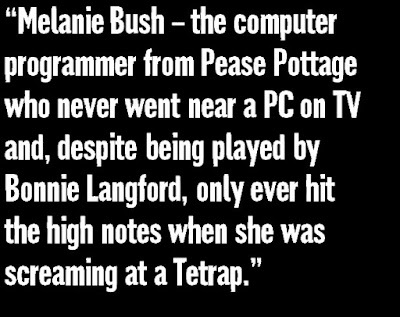 Although... the Doctor doesn’t regenerate, does he? This time, in keeping with both the specials’ non-binary subject matter and the unwritten rule that an anniversary special must develop the show’s already sprawling mythology in some significant way, the Doctor bigenerates.
Although... the Doctor doesn’t regenerate, does he? This time, in keeping with both the specials’ non-binary subject matter and the unwritten rule that an anniversary special must develop the show’s already sprawling mythology in some significant way, the Doctor bigenerates. “Imagine how much fans love new things and will really rejoice when this happens,” quipped RTD as he giggled along with Doctor Who Unleashed . Well, he’s got me pegged. As I saw Ncuti Gatwa emerge from David Tennant’s body, the (now entrenched) views that I first espoused following the Doctor-Donna metacrisis started to spill out of my mouth at almost Tennant-Doctor-like speed. I’ve never liked the idea that the Doctor is somehow divisible or replicable. Hell, years ago I used to get mad at the mere suggestion that different quantum versions of the Doctor played out irreconcilable adventures in media-specific parallel universes as I felt, and I still feel, that the Doctor, for all his multitudes, should be unique. Oh, for the simplicity of those days now.

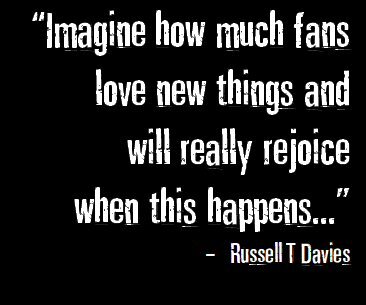 Having the Doctor spawn another self and in so doing also repair the Galvanic beam-sized hole through his torso doesn’t make a lot of sense even within the misty logic of the Whoniverse, which is really saying something. Regeneration is famously a way to cheat death; cheating death while also effectively giving birth feels like the Doctor’s taking the piss.
Having the Doctor spawn another self and in so doing also repair the Galvanic beam-sized hole through his torso doesn’t make a lot of sense even within the misty logic of the Whoniverse, which is really saying something. Regeneration is famously a way to cheat death; cheating death while also effectively giving birth feels like the Doctor’s taking the piss. If you take a look at other big properties in the genre – properties that RTD namechecks in justification of the switch to bigeneration - many people broke faith with Star Wars movies once they started messing about with the nature of the Force in The Last Jedi , and Marvel’s slide into Phase Four and the multiverse has been exactly that – a slide. “The Giggle” goes much further than either Star Wars or Marvel have, though, leaving Doctor Who fans having to contend with a whole new regenerative paradigm that fundamentally alters the nature of their show’s eponymous hero. Putting the carbon-copy of the TARDIS to one side and just looking at the core character issue, who’s Who now? Isn’t a Time Lord the sum of his memories? If so, what happens once these two start making new, separate memories? How can we fret over Ncuti Gatwa’s Doctor when he’s got a proper, Time Lord copy of himself safely backed up in Donna’s back garden? Is David Tennant’s Doctor going to fly off in his “Memory TARDIS” to bookend many a classic adventure in the – I’m sorry, but unbearably twee - Tales of the TARDIS ? Or, more likely, become the humble curator of the Under Gallery, revisiting an “old favourite” face with each subsequent regeneration? Of course, that’s assuming he doesn’t bigenerate again instead. If he does, then by the time of the seventy-fifth anniversary we might have had a Tribble-like outbreak of Doctors.
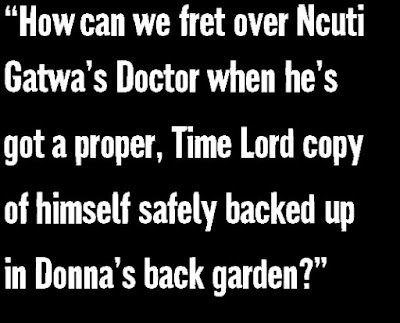 Fortunately Davies is smart enough a scriptwriter to leave the concept of bigeneration woolly enough to allow for interpretation. What interests me the most is the conceit that Gatwa’s Doctor is somehow older than Tennant’s (by my watch, I make them exactly the same age at the end of “The Giggle”) and that, by extension, Gatwa’s Doctor has recovered from his past incarnations’ traumas thanks to the “out of order” rehab that Tennant’s Doctor is about to undertake. The implication is that, unaccountably, Fourteen’s future is still a part of Fifteen’s past; somehow Fourteen’s ongoing experiences must find their way back into Fifteen’s head - and hearts. Well that’s alright then! How the minds of these two divergent Doctors could possibly be reunified is, it seems, another story for another day, but it will no doubt involve the word “contact” and some frantic cutting between close-up eye shots.
Fortunately Davies is smart enough a scriptwriter to leave the concept of bigeneration woolly enough to allow for interpretation. What interests me the most is the conceit that Gatwa’s Doctor is somehow older than Tennant’s (by my watch, I make them exactly the same age at the end of “The Giggle”) and that, by extension, Gatwa’s Doctor has recovered from his past incarnations’ traumas thanks to the “out of order” rehab that Tennant’s Doctor is about to undertake. The implication is that, unaccountably, Fourteen’s future is still a part of Fifteen’s past; somehow Fourteen’s ongoing experiences must find their way back into Fifteen’s head - and hearts. Well that’s alright then! How the minds of these two divergent Doctors could possibly be reunified is, it seems, another story for another day, but it will no doubt involve the word “contact” and some frantic cutting between close-up eye shots.
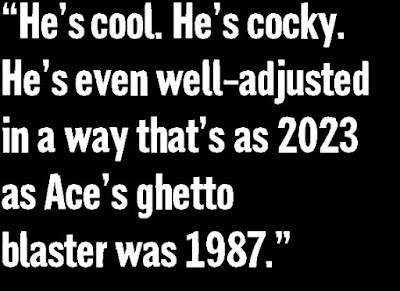 My ire has also been softened by the fact that the execution of the show’s first-ever bigeneration is a thing of a cosmic and comic beauty, with the dissection of the Doctor even extending to parts of his outfit to ensure that both residual incarnations are duly covered where it counts. Making the Doctor’s clothes – and the division thereof – part of the regenerative process was probably about the right level of anniversary leap for me, and I dare say there’ll be a fan or two out there who’d even have reservations about that much of a change, but there’s nonetheless an illicit sense of joy to the whole scene that is largely down to the sheer energy and cool of incoming Time Lord Ncuti Gatwa and all the all-pervading magnificence of David Tennant.
My ire has also been softened by the fact that the execution of the show’s first-ever bigeneration is a thing of a cosmic and comic beauty, with the dissection of the Doctor even extending to parts of his outfit to ensure that both residual incarnations are duly covered where it counts. Making the Doctor’s clothes – and the division thereof – part of the regenerative process was probably about the right level of anniversary leap for me, and I dare say there’ll be a fan or two out there who’d even have reservations about that much of a change, but there’s nonetheless an illicit sense of joy to the whole scene that is largely down to the sheer energy and cool of incoming Time Lord Ncuti Gatwa and all the all-pervading magnificence of David Tennant. Though he’s clearly been aided on this front by Davies’ conscious decision to do away with post-regenerative trauma, I don’t ever recall an incoming Doctor arriving and taking instant command of the role in the way that Gatwa does here. Doing it whilst in the company of one of the most respected Doctors to date - the only man to have been cast in the role twice; arguably The Doctor - makes the feat all the more remarkable. He’s cool. He’s cocky. He’s even well-adjusted in a way that’s as 2023 as Ace’s ghetto blaster was 1987. Self-love, Fourteen, is not so vile a sin as self-neglecting. The jukebox, the mallet and the brotherly arm around the shoulder say it all for me. This Doctor, “Fifteen”, if you will, is going to be phenomenal. And boy can he catch.

Yet Peter Capaldi’s time in the role showed that it doesn’t matter how brilliant the actor playing the Doctor is, if there’s no gas left in the tank, then the show will tank. I’m certainly less confident about this nascent new era after “The Giggle”, and not just because of my reservations about bigeneration and what I see as the dilution of the show’s central character. Whilst some alluring seeds of future dramas have been sown throughout the specials (promises of “Legions”, a veiled reference to “the Boss”, explicit mentions of the Master – and we still have mavity to sort out), seeing that red-nailed hand reach down to collect the gold tooth containing the Master instantly took me back to “Last of the Time Lords” - it’s basically the same shot, just with a gold tooth instead of a ring. And this comes just moments after a new Doctor has defeated a villain up amongst the daytime clouds just by throwing; moments after yet another iteration of David Tennant’s Doctor has been created out of some nebulous regeneration voodoo to give viewers a happy ending when, in my firm view, the Doctor shouldn’t ever get an ending at all. He’s the lonely god. Ancient and forever, that’s him. Or her. Or them.

I think Davies’ hope for “The Giggle” was that it would shake up the status quo and move the series forwards in the same way that “The Five Doctors” and, for better or worse, “The Day of the Doctor” did. However, as enjoyable as it is, “The Giggle” doesn’t feel fresh or innovative; it feels derivative of Davies’ prior work on the show. The Toymaker claims here to have “made a jigsaw” of the Doctor’s history, but Davies’ script plays Guess Who? with the Doctor’s present and future. I’ll keep the faith, of course, and just hope that this time I won’t be vindicated in the way that I was after the Time Lords were saved in “The Day of the Doctor”, only for them to be lost; found; and then promptly destroyed all over again in a series of increasingly futile and demystifying adventures.
All that being said, the return of the Toymaker can’t be regarded as anything but an astonishing triumph (it’s raised his profile enough to finally see an animation of The Celestial Toymaker’s lost episodes commissioned) and now we’ve got the long-overdue present of getting an African-born, energetic and utterly electrifying Doctor for Christmas. In its finest moments, “The Giggle” is a veritable treatise on entitlement and cancel culture, but even with the infamous Toymaker back on the roster spitting venom, there is certainly no danger of Doctor Who getting cancelled anytime soon.
“The Giggle” is available to stream in the UK on BBC iPlayer and overseas on Disney+. You can also watch the episode on iPlayer with an in-vision commentary.
The Celestial Toymaker Blu-ray steelbook is available to pre-order now, with today’s cheapest online retailer being HMV who have it listed for £29.99 with free delivery.
The audio adaptation of The Nightmare Fair, which was originally planned to be the Toymaker’s return to the show in 1985, is available to download from Big Finish Productions for just £7.99. Its sequel,the Companion Chronicle Solitaire, is also available to download for just £2.99. The Magic Mousetrap, also available to download for £7.99 from Big Finish, is also likely to be of interest to fans of the Toymaker.
The BBC novel Divided Loyalties by Gary Russell, which also features the Toymaker, is long out of print but may be available second-hand on eBay.
December 5, 2023
TV Review | Doctor Who: “Wild Blue Yonder” by Russell T Davies
This review contains SPOILERS from the outset.
I didn’t know very much about “Wild Blue Yonder” going into it. Its title was cryptic; there had been no “Next time...” trailer at the end of “The Star Beast”; the episode description published on iPlayer was almost Breaking Bad-vague; and, having been saddened by Bernard Cribbins’ death in July last year, the last character I was expecting to make a comeback here was everybody’s favourite granddad, Wilfred Mott.
But with secrecy comes expectation, in an anniversary special even more so, and for many viewers that expectation was not paid off by an episode in which the Doctor and Donna, as showrunner and writer Russell T Davies put it himself, “...arrive on the spaceship and they meet evil versions of themselves. That’s it.” It’s not, though, it is Russell?

Those expecting a multi-Doctor romp to the tune of an old war song may have felt let down by this second special, but I certainly didn’t. Being treated to a fifty-five-minute two-hander between two of my favourite-ever Doctor Who stars would have been gift enough for any anniversary, but to also have them isolated at the edge of the oblivion and grotesquely duplicated in perhaps the darkest and most twisted narrative that we’ve seen since “Midnight” is nothing short of stellar.
After the rampant, comic adventure of “The Star Beast”, “Wild Blue Yonder” gives the Doctor and Donna some much-needed time to reconnect one-on-one and broach some potentially thorny issues about the events of the subjective millennia for the Doctor that elapsed between “Journey’s End” and the return of Donna’s memories. This enables David Tennant in particular to really establish his new Doctor, who, despite his mannerisms, is gradually being revealed to be a subtly different man to the one who first wore that particular face. There’s emotional maturity there, buried in Davies’ dialogue and etched into David Tennant’s older brow. Don’t be fooled by the gags about the new Doctor finally finding certain human beings attractive - “Fourteen” (we’ve really got to give up with the numbering now...) is more like a regretful ghost sent to make amends for his past life than he is the Time Lord equivalent of a pubescent teenager.

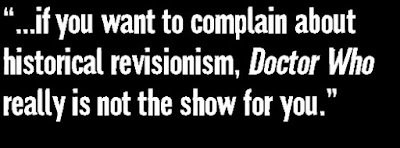 Despite its creepiness and often emotionally heavy subject matter, “Wild Blue Yonder” isn’t without its sense of fun. The pre-title caper involving Sir Isaac Newton, one of the few historical figures of note yet to appear on screen in Doctor Who, instantly re-establishes the Doctor and Donna as the gung-ho adventurers in time and space that they once were while also serving as an amusing setup for a timey-wimey plot point yet to come. The fun of the skit even extends to the post-special furore surrounding the “racebending” that some viewers saw in the casting of Nathaniel Curtis (It’s a Sin), an actor of mixed race, as an individual who, in real life, was most probably Rodney Trotter-white. There’s certainly great irony in armchair pundits bemoaning the colour of an actor’s skin, yet having no issue at all with the time machine nestled in the apple-dropping tree or the inadvertent rebranding of the mutual attraction between all things that have mass from “gravity” to “mavity”. If you want to complain about historical revisionism, I think the latter point has more weight. In fact, if you want to complain about historical revisionism, Doctor Who really is not the show for you. Historical revisionism is exactly what the Doctor does*.
Despite its creepiness and often emotionally heavy subject matter, “Wild Blue Yonder” isn’t without its sense of fun. The pre-title caper involving Sir Isaac Newton, one of the few historical figures of note yet to appear on screen in Doctor Who, instantly re-establishes the Doctor and Donna as the gung-ho adventurers in time and space that they once were while also serving as an amusing setup for a timey-wimey plot point yet to come. The fun of the skit even extends to the post-special furore surrounding the “racebending” that some viewers saw in the casting of Nathaniel Curtis (It’s a Sin), an actor of mixed race, as an individual who, in real life, was most probably Rodney Trotter-white. There’s certainly great irony in armchair pundits bemoaning the colour of an actor’s skin, yet having no issue at all with the time machine nestled in the apple-dropping tree or the inadvertent rebranding of the mutual attraction between all things that have mass from “gravity” to “mavity”. If you want to complain about historical revisionism, I think the latter point has more weight. In fact, if you want to complain about historical revisionism, Doctor Who really is not the show for you. Historical revisionism is exactly what the Doctor does*.
Perhaps the most remarkable thing about “Wild Blue Yonder” though is its beautiful ending, which gives the Doctor – and gives us – the chance to say goodbye to one of Doctor Who’s most enduring characters and one of the franchise’s most beloved contributors. I honestly had no idea that Bernard Cribbins had recorded his cameo for this special so close to his death, and last week’s amusing exchange on the subject of Wilf threw me off the scent of his return completely – I’d thought that bit of banter, beautifully written and played as it was, was the Whoniverse’s goodbye to the old soldier. This, needless to say, is a far more welcome send-off, particularly as it segued magnificently into a cliffhanger ending for the ages. Never waste time on a hug.
“Wild Blue Yonder” is available to stream in the UK on BBC iPlayer and overseas on Disney+. * Since the events of The Highlanders , anyway. Prior to that, the Doctor was much more of a historical conservative (provided he found himself in an era prior to the mid-1960s. History was obviously open to revision after that, even for the first two TV Doctors).
November 27, 2023
TV Review | Doctor Who: “The Star Beast” by Rusell T Davies
 It feels as if somebody has just flicked a switch and restored Doctor Who to the heights of its golden age – which, of course, they have.
It feels as if somebody has just flicked a switch and restored Doctor Who to the heights of its golden age – which, of course, they have. Like Manchester United after Sir Alex Ferguson’s departure, Doctor Who has struggled for consistency ever since Russell T Davies stepped down as showrunner at The End of Time. Both Steven Moffat and Chris Chibnall’s stewardships delivered some incredible highs, but neither of Davies’ successors managed to deliver the relentless, consistent quality and sheer presence of the revived series’ first four seasons. This resulted in a gradual erosion of the show’s profile, funding, and ultimately its success. Companion show Doctor Who Confidential fell by the wayside after Matt Smith’s second year, Peter Capaldi’s tenure saw the annual episode count drop along with the show’s ratings, and the “traditional” Christmas special – the same special was the centrepiece of BBC One’s Christmas Day, spawning many a festive Radio Times cover – was quietly abolished when Jodie Whittaker took over the TARDIS.

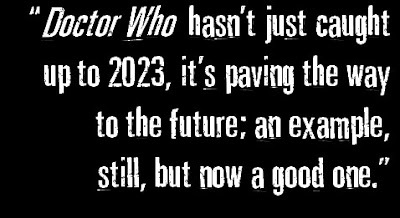 Yet, just as he did in 2005, Davies has managed to update and rebrand Doctor Who for a contemporary, telly-aerial-lite audience. No longer the exclusive preserve of Saturday tea-times, Davies’ new-new-Who is custom-built for streaming and complemented by an unassailable back catalogue of content that’s now available to those of us in the UK at the touch of a button. With Bad Wolf, Davies’ own production company, now producing the show alongside BBC Studios for the BBC in the UK and Disney+ overseas, Doctor Who now possesses the lavish “event” feel that we have come to associate with Disney+’s many Marvel Studios and
Star Wars
properties, right down to the Whoniverse signature that precedes each new episode.
Yet, just as he did in 2005, Davies has managed to update and rebrand Doctor Who for a contemporary, telly-aerial-lite audience. No longer the exclusive preserve of Saturday tea-times, Davies’ new-new-Who is custom-built for streaming and complemented by an unassailable back catalogue of content that’s now available to those of us in the UK at the touch of a button. With Bad Wolf, Davies’ own production company, now producing the show alongside BBC Studios for the BBC in the UK and Disney+ overseas, Doctor Who now possesses the lavish “event” feel that we have come to associate with Disney+’s many Marvel Studios and
Star Wars
properties, right down to the Whoniverse signature that precedes each new episode.
A 4K HDR picture is no longer an iPlayer technical experiment or a rare treat - it’s the show’s new standard, and we are not left wanting for bonus material the likes of Marvel Studios Assembled or Disney Gallery: The Mandalorian. A new episode of Doctor Who Unleashed, seemingly 2023’s answer to both Confidential and Totally Doctor Who, accompanies every broadcast episode, even the Children in Need skit. In-vision commentaries featuring notable members of the cast and crew are no longer reserved for the disc-buying minority – they are available within a couple of days of each episode dropping on iPlayer as part of the service’s ever-expanding and almost exhaustive Whoniverse. Doctor Who hasn’t just caught up to 2023, it’s paving the way to the future; an example, still, but now a good one.

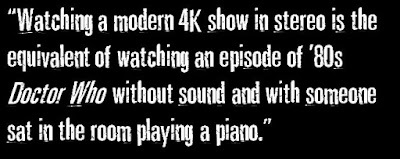 Not a perfect one, mind. There’s still a way to go – iPlayer’s curation of almost every Doctor Who episode ever leaves much to be desired, with the recently-added colourisation of The Daleks seemingly (and somewhat ironically, giving the series’ many wiped episodes) overwriting
An Unearthly Child
at the start of Season 1, for instance. However, what really let “The Star Beast” down was watching it in all of its 2160p HDR glory... and lossy two-channel audio. There is no obvious technical, practical or legal reason that prevents the BBC adding multi-channel audio to iPlayer – it’s just about the only major streaming service without it. Watching a modern UHD show in stereo is the equivalent of watching an episode of ’80s Who without sound and with someone sat in the room playing a piano. Disney+ subscribers abroad will no doubt get the DTS-HD 5.1 Master Audio (or Dolby equivalent, as Disney+ seems to favour) treatment that we’ll all have to wait for a physical release for, but it’s hard to whinge too much when iPlayer is basically free (yes, I know, a British TV licence costs roughly twice as much as a Disney+ subscription, but having one is more legal requirement than optional subscription).
Not a perfect one, mind. There’s still a way to go – iPlayer’s curation of almost every Doctor Who episode ever leaves much to be desired, with the recently-added colourisation of The Daleks seemingly (and somewhat ironically, giving the series’ many wiped episodes) overwriting
An Unearthly Child
at the start of Season 1, for instance. However, what really let “The Star Beast” down was watching it in all of its 2160p HDR glory... and lossy two-channel audio. There is no obvious technical, practical or legal reason that prevents the BBC adding multi-channel audio to iPlayer – it’s just about the only major streaming service without it. Watching a modern UHD show in stereo is the equivalent of watching an episode of ’80s Who without sound and with someone sat in the room playing a piano. Disney+ subscribers abroad will no doubt get the DTS-HD 5.1 Master Audio (or Dolby equivalent, as Disney+ seems to favour) treatment that we’ll all have to wait for a physical release for, but it’s hard to whinge too much when iPlayer is basically free (yes, I know, a British TV licence costs roughly twice as much as a Disney+ subscription, but having one is more legal requirement than optional subscription). 
It’s also akin to cheating that “The Star Beast”, and indeed this whole run of specials, is built on the success of new Who’s finest season and the Whoniverse’s greatest-ever Doctor and companion – not that we care. It’s a testament to Davies’ genius that he identified the need for a tried-and-tested team to galvanise his newly-minted Whoniverse and celebrate the show’s diamond anniversary, and David Tennant and Catherine Test do not let him down. Armed with Davies’ heart-warming and humorous dialogue, both actors clearly relished the opportunity to reprise the Doctor-Donna, dazzling throughout.

A criticism often aimed at Chris Chibnall’s era was that it was either “too woke” or, perhaps a little more justifiably, sometimes “woke at the expense of substance”, but RTD’s script for “The Star Beast” weaves current issues seamlessly into the fabric of its plot and, ingeniously, even uses them to resolve what, fifteen years ago, seemed unsolvable. That it does so whilst simultaneously restoring domesticity to its rightful place at the heart of the show and laying the foundations for a third UNIT era – and, no doubt, another Big Finish spin-off range of UNIT audio dramas... – again speaks to Davies’ talents as not just a writer but also rightful Master of the Whoniverse.
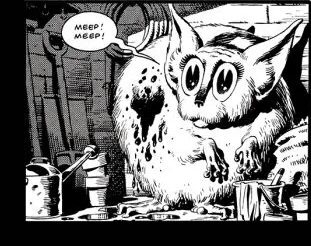 However, though “The Star Beast” is indubitably the very model of a Russell T Davies script, its inspiration and even its title are a Pat Mills (Dead London, The Scapegoat) comic strip of the same name first published in the page of Doctor Who Weekly (now Doctor Who Magazine) in 1980 and immortalised by Big Finish Productions in 2019 when they had Alan Barnes adapt it into a full-cast audio drama. RTD deserves the credit, though, for choosing a villain capable of satisfying even the most hardened of fans’ nostalgic cravings while still entertaining casual viewers. Chances are, if you’ve heard of one Doctor Who comic-book villain, then it’s Beep the Meep, and it’s because everyone gets – and everyone loves – the ludicrous idea that one of the Whoniverse’s cutest creatures is also one of its most vicious. Miriam Margolyes (Blackadder) gives an absolute worldie of a vocal performance as the Meep – no pronouns for the Meep, just the definite article – whose core story stays faithful to that first illustrated in black and white by Dave Gibbons (
Watchmen
) more than forty years ago.
However, though “The Star Beast” is indubitably the very model of a Russell T Davies script, its inspiration and even its title are a Pat Mills (Dead London, The Scapegoat) comic strip of the same name first published in the page of Doctor Who Weekly (now Doctor Who Magazine) in 1980 and immortalised by Big Finish Productions in 2019 when they had Alan Barnes adapt it into a full-cast audio drama. RTD deserves the credit, though, for choosing a villain capable of satisfying even the most hardened of fans’ nostalgic cravings while still entertaining casual viewers. Chances are, if you’ve heard of one Doctor Who comic-book villain, then it’s Beep the Meep, and it’s because everyone gets – and everyone loves – the ludicrous idea that one of the Whoniverse’s cutest creatures is also one of its most vicious. Miriam Margolyes (Blackadder) gives an absolute worldie of a vocal performance as the Meep – no pronouns for the Meep, just the definite article – whose core story stays faithful to that first illustrated in black and white by Dave Gibbons (
Watchmen
) more than forty years ago.
There is also something fitting about using a comic strip as the launching pad for the second coming of Russell T Davies as, particularly with hindsight, his first run on the show was typified by its larger-than-life, bombastic tone - a quality that returns full force here thanks to the colourful direction of Rachel Talalay (Sherlock, The Flash) and particularly Murray Gold’s resurgent score.
Like all good openers, “The Star Beast” begs more questions than it answers, and it does so whilst telling a fast-paced and solid science-fiction story couched in all the heart and all the humour that made Doctor Who the household sensation that it was fifteen years ago – and will now be again.
“The Star Beast” is available to stream in the UK on BBC iPlayer and overseas on Disney+. You can also watch the episode on iPlayer with an in-vision commentary.
A Target novelisation of the episode is now available to pre-order from all good booksellers and Amazon.
The original Doctor Who and the Star Beast comic strip is collected in Panini’s Doctor Who: The Fourth Doctor Anthology. Today’s cheapest online retailer in the UK is Amazon who have it listed for £23.89.
Alan Barnes’ full-cast audio adaptation of Doctor Who and the Star Beast is available to download from Big Finish Productions for £24.99 as part of Doctor Who: The Comic Strip Adaptations – Volume One.
TV Review | Doctor Who: “The Star Beast” by Rusell T. Davies
 It feels as if somebody has just flicked a switch and restored Doctor Who to the heights of its golden age – which, of course, they have.
It feels as if somebody has just flicked a switch and restored Doctor Who to the heights of its golden age – which, of course, they have. Like Manchester United after Sir Alex Ferguson’s departure, Doctor Who has struggled for consistency ever since Russell T Davies stepped down as showrunner at The End of Time. Both Steven Moffat and Chris Chibnall’s stewardships delivered some incredible highs, but neither of Davies’ successors managed to deliver the relentless, consistent quality and sheer presence of the revived series’ first four seasons. This resulted in a gradual erosion of the show’s profile, funding and ultimately its success. Companion show Doctor Who Confidential fell by the wayside after Matt Smith’s second year. Peter Capaldi’s tenure saw the annual episode count drop along with the show’s ratings. And the “traditional” Christmas special – the same special that spawned many a festive Radio Times cover – was quietly abolished when Jodie Whittaker took over the TARDIS.

 Yet, just as he did in 2005, Davies has managed to update and rebrand Doctor Who for a contemporary, TV aerial-lite audience. No longer the exclusive preserve of Saturday tea-times, Davies’ new-new-Who is custom-built for streaming and backed up with an unassailable back catalogue of content that’s now available to those of us in the UK at the touch of a button. With Bad Wolf, Davies’ own production company, now producing the show alongside BBC Studios for the BBC in the UK and Disney+ overseas, Doctor Who now possesses the lavish “event” feel that we have come to associate with Disney+’s many Marvel and
Star Wars
properties, right down to the Whoniverse signature that precedes each new episode.
Yet, just as he did in 2005, Davies has managed to update and rebrand Doctor Who for a contemporary, TV aerial-lite audience. No longer the exclusive preserve of Saturday tea-times, Davies’ new-new-Who is custom-built for streaming and backed up with an unassailable back catalogue of content that’s now available to those of us in the UK at the touch of a button. With Bad Wolf, Davies’ own production company, now producing the show alongside BBC Studios for the BBC in the UK and Disney+ overseas, Doctor Who now possesses the lavish “event” feel that we have come to associate with Disney+’s many Marvel and
Star Wars
properties, right down to the Whoniverse signature that precedes each new episode.
A 4K HDR picture is no longer an iPlayer technical experiment or a rare treat - it’s the show’s new standard, and we are not left wanting for bonus material the likes of Marvel Studios Assembled or Disney Gallery: The Mandalorian. A new episode of Doctor Who Unleashed, seemingly 2023’s answer to both Confidential and Totally Doctor Who, accompanies every broadcast episode, even the Children in Need skit. In-vision commentaries featuring notable members of the cast and crew are no longer reserved for the disc-buying minority – they are available within a couple of days of each episode dropping on iPlayer as part of the service’s ever-expanding and almost exhaustive Whoniverse. Doctor Who hasn’t just caught up to 2023, it’s paving the way to the future; an example, still, but now a good one.

 Not a perfect one, mind. There’s still a way to go – iPlayer’s curation of almost every Doctor Who episode ever leaves much to be desired, with the recently-added colourisation of The Daleks seemingly (and somewhat ironically, giving the series’ many wiped episodes) overwriting
An Unearthly Child
at the start of Season 1, for instance. However, what really let “The Star Beast” down was watching it in all of its 2160p HDR glory... and lossy two-channel audio. There is no obvious technical, practical or legal reason that prevents the BBC adding multi-channel audio to iPlayer – it’s just about the only major streaming service without it. Watching a modern 4K show in stereo is the equivalent of watching an episode of ’80s Who without sound and with someone sat in the room playing a piano. Disney+ subscribers abroad will no doubt get the DTS-HD 5.1 Master Audio (or Dolby equivalent, as Disney+ seems to favour) treatment that we’ll all have to wait for a physical release for, but it’s hard to whinge too much when iPlayer is basically free (yes, I know, a British TV licence costs roughly twice as much as a Disney+ subscription, but having one is a legal requirement if you own a TV, so we aren’t comparing like for like).
Not a perfect one, mind. There’s still a way to go – iPlayer’s curation of almost every Doctor Who episode ever leaves much to be desired, with the recently-added colourisation of The Daleks seemingly (and somewhat ironically, giving the series’ many wiped episodes) overwriting
An Unearthly Child
at the start of Season 1, for instance. However, what really let “The Star Beast” down was watching it in all of its 2160p HDR glory... and lossy two-channel audio. There is no obvious technical, practical or legal reason that prevents the BBC adding multi-channel audio to iPlayer – it’s just about the only major streaming service without it. Watching a modern 4K show in stereo is the equivalent of watching an episode of ’80s Who without sound and with someone sat in the room playing a piano. Disney+ subscribers abroad will no doubt get the DTS-HD 5.1 Master Audio (or Dolby equivalent, as Disney+ seems to favour) treatment that we’ll all have to wait for a physical release for, but it’s hard to whinge too much when iPlayer is basically free (yes, I know, a British TV licence costs roughly twice as much as a Disney+ subscription, but having one is a legal requirement if you own a TV, so we aren’t comparing like for like). 
It’s also akin to cheating that “The Star Beast”, and indeed this whole run of specials, is built on the success of the revived series’ finest season and the Whoniverse’s greatest-ever Doctor and companion – not that we care. It’s a testament to Davies’ genius that he identified the need for a tried-and-tested team to galvanise his Whoniverse and celebrate the show’s diamond anniversary, and David Tennant and Catherine Test do not let him down. Armed with Davies’ heart-warming and humorous dialogue, both actors clearly relished the opportunity to reprise the Doctor-Donna, dazzling throughout.

A criticism often aimed at Chris Chibnall’s era was that it was either “too woke” or, perhaps a little more justifiably, often “woke at the expense of substance”, but RTD’s script for “The Star Beast” weaves current issues seamlessly into the fabric of its plot and, ingeniously, even uses them to resolve what, fifteen years ago, seemed unsolvable. That it does so whilst simultaneously restoring the companion’s family to their rightful place at the heart of the show and laying the foundations for a third UNIT era – and, no doubt, another Big Finish range of UNIT audio dramas... – again speaks to Davies’ talents as not just a writer but also as the incumbent Master of the Whoniverse.
 However, though “The Star Beast” is indubitably the very model of a Russell T Davies script, its inspiration and even its title are a Pat Mills (Dead London, The Scapegoat) comic strip of the same name first published in the page of Doctor Who Weekly (now Doctor Who Magazine) in 1980 and immortalised by Big Finish Productions in 2019 when they had Alan Barnes adapt it into a full-cast audio drama. RTD deserves the credit, though, for choosing a villain capable of satisfying even the most hardened of fans’ nostalgic cravings while still entertaining casual viewers. Chances are, if you’ve heard of one Doctor Who comic-book villain, then it’s Beep the Meep, and it’s because everyone gets – and everyone loves – the ludicrous idea that one of the Whoniverse’s cutest creatures is also one of its most vicious. Miriam Margolyes (Blackadder II) gives an absolute worldie of a vocal performance as the Meep – no pronouns for the Meep, just the definite article – whose core story stays faithful to that first illustrated in black and white by Dave Gibbons (
Watchmen
) more than forty years ago.
However, though “The Star Beast” is indubitably the very model of a Russell T Davies script, its inspiration and even its title are a Pat Mills (Dead London, The Scapegoat) comic strip of the same name first published in the page of Doctor Who Weekly (now Doctor Who Magazine) in 1980 and immortalised by Big Finish Productions in 2019 when they had Alan Barnes adapt it into a full-cast audio drama. RTD deserves the credit, though, for choosing a villain capable of satisfying even the most hardened of fans’ nostalgic cravings while still entertaining casual viewers. Chances are, if you’ve heard of one Doctor Who comic-book villain, then it’s Beep the Meep, and it’s because everyone gets – and everyone loves – the ludicrous idea that one of the Whoniverse’s cutest creatures is also one of its most vicious. Miriam Margolyes (Blackadder II) gives an absolute worldie of a vocal performance as the Meep – no pronouns for the Meep, just the definite article – whose core story stays faithful to that first illustrated in black and white by Dave Gibbons (
Watchmen
) more than forty years ago. 
Like all good openers, “The Star Beast” begs more questions than it answers, and it does so whilst telling a fast-paced and solid science-fiction story couched in all the heart and all the humour that made Doctor Who the household sensation that it was fifteen years ago – and will now be again.
“The Star Beast” is available to stream in the UK on BBC iPlayer and overseas on Disney+. You can also watch the episode on iPlayer with an in-vision commentary.
A Target novelisation of the episode is now available to pre-order from all good booksellers and Amazon.
The original Doctor Who and the Star Beast comic strip is collected in Panini’s Doctor Who: The Fourth Doctor Anthology. Today’s cheapest online retailer in the UK is Amazon who have it listed for £23.89.
Alan Barnes’ full-cast audio adaptation of Doctor Who and the Star Beast is available to download from Big Finish Productions for £24.99 as part of Doctor Who: The Comic Strip Adaptations – Volume One.
November 18, 2023
TV Review | Doctor Who: "Destination: Skaro" [2023 Children in Need Special] by Russell T Davies
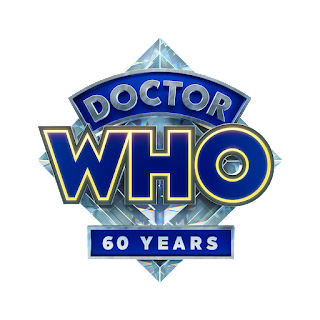 Russell T Davies has been back at the helm of the TARDIS for five minutes (well, 4:54, to be precise) and already the show is bursting with the heart, humour and intrigue that defined his original tenure. The show’s 2023 Children in Need special, untitled on screen but widely referred to as “Destination: Skaro” in various social media posts, serves as a delectable entrée to the three-course meal of specials that are about to be served up.
Russell T Davies has been back at the helm of the TARDIS for five minutes (well, 4:54, to be precise) and already the show is bursting with the heart, humour and intrigue that defined his original tenure. The show’s 2023 Children in Need special, untitled on screen but widely referred to as “Destination: Skaro” in various social media posts, serves as a delectable entrée to the three-course meal of specials that are about to be served up.Paying homage to the fan-favourite 1975 serial Genesis of the Daleks, “Destination: Skaro” sees David Tennant’s new Doctor crash-land on Skaro some time prior to Tom Baker’s Doctor’s notorious meddling in the planet’s history, at a point when Davros’s prototype Mark III Travel Machine has just rolled off the production line. Davies’ wry script delights in poking fun at the ridiculousness of the Daleks’ anagrammatic nomenclature and infamous sink-plunger appendages, while also treating long-standing viewers to some unashamedly nostalgic Easter eggs such as Peter Miles’ reprising the role of Nyder from Genesis.
Tennant is instantly back to his exuberant best, almost literally bouncing off Mawaan Rizwan’s (Sex Education) confused Kaled scientist to superb comic effect. It is another Kaled scientist, though, that is the skit’s main talking point: Davros, soon-to-be creator of the Daleks. Whilst Big Finish audio dramas have explored Davros’s life prior to the incident that left him disfigured and disabled, all we have seen of that life on screen is the few moments from his childhood that formed part of Steven Moffat’s “The Magician’s Apprentice” / “The Witch’s Familiar” two-parter back in 2015. “Destination: Skaro”, inventively, gives Julian Bleach the opportunity to portray the megalomaniacal scientist - this time without the straitjacket of prosthetics. This, in of itself, makes this little charity special a real treat.

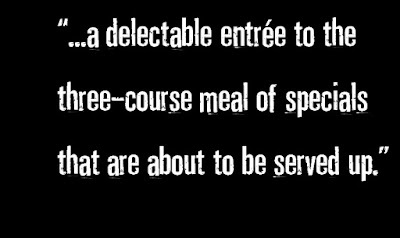 Like many viewers, my thoughts as I watched this minisode were simply that its events must have taken place prior to Davros’s life-changing injuries; however, those who tuned into the series’ new companion show, Doctor Who Unleashed, as I did, will have learned there was more to this than merely giving long-standing fans an illicit thrill. Keen to right a wrong that has persisted since the earliest days of theatre in which the disabled and/or disfigured are often portrayed as villains, Davies has taken the bold decision to no longer depict Davros as a “wheelchair user”. Whilst personally I have never heard anyone refer to the self-styled “Lord and Creator of the Daleks” as a wheelchair user – “Half-man, half-Dalek” seems to be the phrase ubiquitously thrown around by casual viewers, and, truth be told, by the late ’80s Davros wasn’t much more than a head – I have to admire the boldness of Davies’ conviction and, once again, his incredible vision for what Doctor Who can and should be.
Like many viewers, my thoughts as I watched this minisode were simply that its events must have taken place prior to Davros’s life-changing injuries; however, those who tuned into the series’ new companion show, Doctor Who Unleashed, as I did, will have learned there was more to this than merely giving long-standing fans an illicit thrill. Keen to right a wrong that has persisted since the earliest days of theatre in which the disabled and/or disfigured are often portrayed as villains, Davies has taken the bold decision to no longer depict Davros as a “wheelchair user”. Whilst personally I have never heard anyone refer to the self-styled “Lord and Creator of the Daleks” as a wheelchair user – “Half-man, half-Dalek” seems to be the phrase ubiquitously thrown around by casual viewers, and, truth be told, by the late ’80s Davros wasn’t much more than a head – I have to admire the boldness of Davies’ conviction and, once again, his incredible vision for what Doctor Who can and should be.
That distinctive Davros silhouette, perhaps used most effectively in Davies’ own “The Stolen Earth” fifteen years ago, has been a cornerstone of the show’s mythology for almost fifty years, and as a result there won’t be many honest fans out there that won’t lament its loss going forward. However, most of us will readily admit that Davros’s disabilities have always been superficial – he was designed to be deliberately monstrous for no reason other than tradition and cliché. Lance Parkin’s seminal twenty-year-old, eponymous audio play even went so far as to describe Davros’s injuries as being “the least of his problems”, or words to that effect, yet they have had a massive impact on how performers have been able to play him. With actors’ reduced to near immobility and unable to use anything but the most extreme of facial expressions, in the past the role of Davros has been almost entirely vocal. Terry Molloy in particular made an art of channelling everything through his voice, imbuing Davros with a distinctive brand of hysterical mania that, for decades, has been as defining as Darth Vader’s mechanical breath. Now, all of a sudden, Bleach has been given the opportunity to use all the tools at his disposal to take a fifty-year-old character somewhere new and potentially groundbreaking – and there’s nothing more Who than that.

Times change, and time can be rewritten. Doctor Who has reached the sixty-year mark because of its adaptability, not in spite of it. The series’ ability to stay relevant in an ever-changing world remains one of its core strengths. “Destination: Skaro” may ultimately prove to be nothing more than an interesting footnote on Davros’s Wikipedia page; a statement of intent from a returning showrunner. I hope, though, that it’s the shadow of many a wibbly-wobbly, timey-wimey Skarosian adventure to come – adventures that could see the Doctor and Davros finally go toe-to-toe.
“Destination: Skaro” is available to stream on iPlayer, home of the entire Whoniverse. Well, nearly.
I, Davros and Doctor Who: Davros are available to download from Big Finish Productions for £12.99 and £2.99 respectively.
May 14, 2021
Media Studies: On Control, Censorship, Self-determination and Whether The Mandalorian Will Ever Be Available on Blu-ray

Appointment television is no longer a thing. Most millennials would probably find the notion of having to sit down at a broadcaster-dictated time to watch a programme utterly preposterous, and they wouldn’t be far wrong. Even I, perched precariously on the cusp on middle age as I am, have only watched seven episodes of a show “live” in last couple of years (Line of Duty, obviously). Don’t get me wrong, if my phone pings to tell me that there’s a new episode of Better Call Saul on Netflix, I’m all over it that same day – but at a time when it’s convenient for me.
[image error] Above: The last stand of appointment television - BBC One’s Line of Duty.
Advances in streaming technology have kept pace with consumers’ demand for convenience, creating an extraordinarily low-cost yet extremely high-quality marketplace where viewers and listeners can access unprecedented amounts of content on demand. Assuming that you can afford to subscribe to most video-on-demand services and a single music one, you can feel just like a crewman on the Starship Enterprise, with almost the total sum of human culture only ever just a “Siri” or an “Alexa” away (or a “Computer”, if you don’t mind fiddling with your settings to get the full Enterprise effect). [image error]
Despite years of careful acquisition and curation, I haven’t listened to any music from my own iTunes library for a long time. It’s all Apple Music these days, quick and seductive. Admittedly, this is largely due to me never getting the chance to listen to any proper music anymore (as my kids dictate the soundtrack to our lives), but, even so, pre-subscription I was throwing away endless £0.99s on some of the most vapid, jaunty tunes imaginable for the sprogs. I miss the excitement of ripping the shrinkwrap off a new CD, though - almost as much as I miss choosing what I’ll listen to. Fortunately, with the marketplace as it is, I know that I could still buy an album if I wanted to (even one of The Mandalorian’s many, many soundtracks), and in the meantime I’m at least saving some wear and tear on my index finger and Apple Wallet.

Even books aren’t immune to the march of expediency, with the likes of Kindle Unlimited attempting to digitise the library experience, albeit with a limited catalogue, and of course Audible serving as its audiobook sister service. There are also newer services like Readly effectively compressing an entire newsagents (sans the top shelf) into a single app. It’s saved the missus a fortune on her monthly magazines already - and the planet a fair few trees.
[image error]
 In the last forty years, rarely has a decade passed without one home media format superseding another, but never before has the media landscape changed so dramatically – and so fundamentally. In the past, music leapt from vinyl to CDs and back again as it transcended mainstream physical media altogether. There was some messing about with tapes along the way – a form of piracy so feeble that it was tacitly accepted by just about everyone - and even some foolhardy business with MiniDiscs, but those of us who went down that dark path never talk about it. VHS was replaced by DVDs and DVRs, which in turn found themselves quickly outmoded by HDD recorders and Blu-ray discs. The Blu-ray disc evolved to hold twice the amount of data so that it could carry 4K UHD video, and last year’s
Game of Thrones
release pushed the bar further still with the first triple-layer 150GB discs. Meanwhile, satellite TV grew from a premium multi-channel service to a PVR that allowed its viewers to record, pause and instantly rewind live TV (which, I gather, impressed some people who had yet to realise that it was live TV itself that was the problem – not one’s former inability to rewind it). Throughout all this, though, a single pattern held: people bought stuff. They owned it. Albums on CD. Movies on video. DVD box sets. iTunes downloads. Blu-ray steelbooks.
In the last forty years, rarely has a decade passed without one home media format superseding another, but never before has the media landscape changed so dramatically – and so fundamentally. In the past, music leapt from vinyl to CDs and back again as it transcended mainstream physical media altogether. There was some messing about with tapes along the way – a form of piracy so feeble that it was tacitly accepted by just about everyone - and even some foolhardy business with MiniDiscs, but those of us who went down that dark path never talk about it. VHS was replaced by DVDs and DVRs, which in turn found themselves quickly outmoded by HDD recorders and Blu-ray discs. The Blu-ray disc evolved to hold twice the amount of data so that it could carry 4K UHD video, and last year’s
Game of Thrones
release pushed the bar further still with the first triple-layer 150GB discs. Meanwhile, satellite TV grew from a premium multi-channel service to a PVR that allowed its viewers to record, pause and instantly rewind live TV (which, I gather, impressed some people who had yet to realise that it was live TV itself that was the problem – not one’s former inability to rewind it). Throughout all this, though, a single pattern held: people bought stuff. They owned it. Albums on CD. Movies on video. DVD box sets. iTunes downloads. Blu-ray steelbooks. [image error] Above: Watch in 4K HDR with Atmos sound on disc, or on NOW in “Full HD” (well, the frame at least might be 1080p...)
[image error] For years, we’d suffer through our favourite shows on the telly as they were carved up into four acts and interspersed with advertisements, only to later buy them on VHS or disc so that we could enjoy them unsullied by logos and ads, in far greater quality than when they were transmitted and alongside some exclusive bonus material. Now, though, once original content drops on a service, it’s available on demand indefinitely thereafter, and even if it’s not quite up disc quality, the difference is imperceptible to many viewers. For the vast majority of people who’ve not invested in a 4K UHD Blu-ray disc player, 4K HDR streaming is sure to be a huge step up from what they’ve previously been used to. As such, to general consumers, the shift from broadcasting and home video to streaming is, obviously, an incredibly welcome one. But such convenience comes at a cost, even if it’s not necessarily financial.

[image error] Subscriptions to even just the most popular of on-demand services will make quite a dent in your monthly outgoings; however, when accounting for inflation it actually amounts to far less than many people will have paid for satellite TV packages and the odd DVD box set in the past, and in terms of quality there is no comparison at all. The best streaming services are now churning out critically acclaimed original movies and shows at a staggering rate, most of them presented in impressive 4K HDR and with decent (if lossy) multi-channel audio to boot, and of course each also boasts a varied – albeit apparently random, in most cases – back catalogue of historic content that can be viewed on demand.
 Above: Netflix's Marvel Cinematic Universe shows have only a small presence on Blu-ray and digital in the UK.
Above: Netflix's Marvel Cinematic Universe shows have only a small presence on Blu-ray and digital in the UK.No, the real cost of subscription services can’t be measured in pounds and pence, but rather terms of their impact on collective fandom - and in particular the passionate nerd’s instinctive urge to collect. This matter has been quietly gathering steam for several years now, ever since Netflix stopped releasing their various “street level” Marvel series on home video (The Defenders has yet to see the light of day on disc, while later seasons of the peerless Jessica Jones and passable Iron Fist still aren’t commercially available at all in the UK), but the arrival of Disney+, with its new mainstream Star Wars and Marvel programming, has brought the matter to a T-visored head.
[image error] Streaming services not making their originals available to purchase is nothing new, of course, but as wonderful as, say, Ricky Gervais’ After Life, is, the prospect of not being able to own their own copy doesn’t send entire legions of people into the sort of rabid frenzy you might find a Star Wars devotee in when he/she/they realises that, having spent most of his/her/their life slavishly hoarding discs and tie-in merch, The Mandalorian won’t ever sit gleaming away on his/her/their shelf in a case hewn from molten beskar. To such folk, and I’m very much afraid that I’m one of them, the idea of not being able to further their prized collections (they can never be complete...), is akin to telling a Christian that, going forward, the Bible will only be available to read on the Kindle Unlimited service.

But then I had a Mando taking his helmet off sort of moment. As I caught myself idly Googling “Mandalorian Season 1 Blu-ray release date” for about the eighth time this week, a few startlingly obvious truths hit me:
(i) I could watch The Mandalorian again at any time on Disney+, which I’ve no plans to cancel as it continues to regularly bombard me with enticing new Star Wars and Marvel shows for a preposterously low annual fee;
(ii) I don’t really want to watch The Mandalorian again at the minute;
(iii) I don’t have time to watch The Mandalorian again at the minute;
(v) I still haven’t got round to watching all of the Disney Gallery: The Mandalorian docuseries, which, from what I’ve seen, is of a much higher quality than most home video special features are these days.
(vi) I can no longer count using Roman numerals.
So why do I want to chuck fifty to sixty quid at an environmentally-unfriendly product that both technology and society at large have decreed is obsolete? Surely it’s not just for a shiny steel case? Wouldn’t that money be better spent on another year’s Disney+ subscription? Surely... this isn’t the way?
It’s a difficult question for me to answer, and as such it’s easy to see why Disney executives have yet to commit to any sort of physical or even digital release, particularly when they have to weigh the current exclusivity of their content (and the countless subscriptions that it yields) against any short-term financial gain to be made in making it commercially available in another form. Until this January, The Mandalorian was Disney+’s big poster show, and even with all the new Marvel series gradually assuming its thunder, I still believe it’s their biggest draw.
Whilst on our biggest TV and Atmos sound system, physical media does look and sound much better than purchased or streamed content (the bitrate of streamed 4K is often half of a 1080p Blu-ray’s and just a fraction of a 4K UHD disc’s, and much of Disney+’s content is limited to 5.1 surround - even the Star Wars movies which boasted Atmos soundtracks on last year’s 4K UHD physical release), the most honest answer is that I just like collecting media. I love holding it. Appreciating the artwork. Devouring the collector’s booklets. Knowing that I have the best possible version available to watch on demand without having to sign in to something and get bloated on cookies. Like a rich man who fritters away millions on old paintings, it’s as much about ownership as it is appreciation. I like being a freeholder, not a tenant. This is the way.
[image error]
[image error] Such abstruse motivations will be of little interest to Disney and Lucasfilm, though, and constructing a practical argument for home video releases in the 2020s is much more difficult when you consider that, in no time at all, better technology will close the gap in quality between digital and physical content. I can’t even hide behind the old, “My Internet is rubbish” argument anymore because I’m on KC’s best Lightstream package. Though pricey, it is insanely fast and efficient - I’ve had more power cuts in the last year than I’ve had buffering issues. Likewise, whilst I’ve always been quick to lament the shoddy housekeeping of many streaming services – episodes presented in the wrong order (BritBox...), or with the wrong thumbnails (BritBox...), or with metadata so riddled with typos and inaccuracies that it would never have got passed the VPRC (Amazon, Netflix, NOW, BritBox, Apple TV+...) – I certainly can’t level the same complaint at Disney+, which not only boasts a beautiful interface with regularly refreshed, stunning 4K artwork (check out the new May the Fourth images, if you haven’t already), but also appears to take reasonable care when it comes to tagging. Even bonus material – yes, Disney+ movies boast “Extras” of the type once exclusive to home video releases, not to mention specially commissioned docuseries for all of its flagship shows – is neatly presented and nicely tagged under a separate tab. Hell, I can’t even whinge about The Simpsons being the wrong shape anymore as Disney+ lets you choose to watch the episodes in their original aspect ratio, if you prefer, remembering your preference so you don’t have to opt-out of the bastardised versions every time.
 Above: Rest in peace, DVD extras?
Above: Rest in peace, DVD extras?In the early days of streaming, you’d hear horror stories about content suddenly vanishing – something that shouldn’t happen with media that you own (unless you lend it out to unreliable friends... or get burgled... or accidentally scrape scissors across the surface of a disc, as, unaccountably, a lot of people seem to do). Yet, even with licensed third-party content, most providers now give ample warning on when a movie or series will leave their service, and such things are, to date, unheard of with a service’s original programming – and it’s only such content that I’m concerned with here. A lot of older programming may be destined to forever float between services, but “originals” should have the same sort of permanence as if they were burned into a disc on a shelf.
Or so I keep telling myself.
 Above: Remember when The Simpsons used to start their seasons with episode 2? No, I don’t either.
Above: Remember when The Simpsons used to start their seasons with episode 2? No, I don’t either. Yet one or two things give the cynic in me pause. The control freak in me that won’t concede a single decision to anyone else recoils in disgust when he remembers that someone, somewhere in the echelons of Disney decided that The Simpsons’ third-season premiere, “Stark Raving Dad”, was too controversial to be hosted on Disney+ after two men accused guest star Michael Jackson of sexually abusing them when they were young boys. Now I loathe censorship in all its forms, but I particularly take umbrage with people who are unable to separate an artist’s work from their personal life and, rather than simply boycott that artist themselves, they try to force everyone else to do so too. Yet watching “Stark Raving Dad” is no endorsement of Michael Jackson or his alleged wrongdoing; it’s enjoying The Simpsons. Watching The Mandalorian doesn’t mean that you agree with Gina Carano’s contentious social media posts, or indeed the opposing philosophies of her woke co-stars. Entertainment is supposed to be an escape from all that shite.
[image error] Above: Carasynthia Dune - not Gina Carano, the actress who played her before she annoyed the Internet.
But herein lies the danger: when content lives exclusively on a streaming service, it’s vulnerable to the whims and caprices of corporations and their perceptions of viewers’ sensibilities, which have never been more sensitive. I wouldn’t be surprised at all to see half the Russell T Davies era of Doctor Who vanish from wherever it currently resides just because Noel Clarke is facing allegations of sexual harassment and John Barrowman used to get his cock out a lot on set. Fortunately for me, every potentially “offensive” episode of Who is steel-clad on a disc on my shelf, and so I couldn’t care less about its online fate, but were Disney+ to ever to revise or remove The Mandlorian, there’d be no way for me to see it again, or at least see it again as it exists today. And let’s face it, the franchise has got form on this front: just look at the number George Lucas did on his original Star Wars cut, and that was years before both streaming and hypersensitive consumerism. The only copy of the original Star Wars movie that I own stands all of 326 pixels tall on a letterboxed and pillarboxed DVD, and even that took some hunting down.
 Above: Poor Mickey the Idiot. Likely to be struck from the public record just for looking like a young Noel Clarke.
Above: Poor Mickey the Idiot. Likely to be struck from the public record just for looking like a young Noel Clarke.
I also find streaming very limited in a practical sense when measured against both discs and purchased digital media. As if punishing subscribers for having spent the late nineties and much of the noughties stretching and compressing the people on their screens using every ill-conceived means that their hefty old widescreen CRT tellies provided them with, most subscription services now lock their content in a 16:9 frame irrespective of its live dimensions. Whether it’s a film in 2.35:1, an old show in 4:3 or a modern programme in any of the dozens of aspect ratios in between, streaming services’ apps lock out your options to zoom in on the image, which is a real pain if you’re trying to watch a 2.35:1 movie on a 16:9 phone or small 16:9 TV. With discs (and iTunes purchases, for that matter), you can zoom in as and when you please - on an iOS device or an Apple TV it’s a simple as a double-tap. Streaming services, rob you of a useful choice with one hand, and with the other give you an option to watch things at the wrong speed. Madness.
[image error] Above: Well that’s gym night ruined. So much for the upcycled dumb TV / Apple TV 3.
Worse still is my inability to watch subscription content where I want to. I have an old third-generation Apple TV in my gym plugged into a 40” dumb TV, and I can mirror any of my iTunes downloads to it using the Apple TV app, but not an episode of something downloaded from Disney+. Or BritBox. Or Amazon. Or Netflix... With streaming services, it all has to be on their (often poorly thought-out) terms. And so the debate on physical media isn’t necessarily about tangible vs intangible, or even renting vs ownership, anymore - it’s all about self-determination. All about control.

And so will The Mandalorian ever get a home video release? Or WandaVision? Or The Falcon and the Winter Soldier? Or The Bad Batch? Or the final seasons of The Clone Wars and Marvel’s Agents of SHIELD? I certainly hope so, for the reasons outlined above, but my feeling on the matter is that over the next few years the last vestiges of physical media will disappear like the Jedi after Order 66. At best, certain high-end, specialist releases may endure as the video connoisseur’s equivalent to vinyl, but I’m not especially hopeful given the apparently poor sales performance of even recent 4K UHD steelbooks. A couple of years ago, pre-orders would sell out within hours of a release being announced, whereas today, Zavvi are still struggling to shift last year’s stunning “Skywalker Saga” 4K UHD steelbooks even having slashed their price (just £24.99 a chuck now, if you’re interested). The main reason we don’t have Star Trek: Deep Space Nine and Star Trek: Voyager on Blu-ray is because CBS spent a fortune painstakingly remastering Star Trek: The Next Generation from its original film elements, only to find that there was only me and fourteen other fans waiting to buy it. We must remember that markets are consumer-driven, and passionate fans only account for a fraction of mainstream sales.
 Above: Warner Bros and DC continue to support home video with the Snyder Cut on 4K UHD Blu-ray.
Above: Warner Bros and DC continue to support home video with the Snyder Cut on 4K UHD Blu-ray.Some will take comfort in the fact that many similar franchises (DC, Star Trek ) still make their original content available to purchase on home video (and, in DC’s case, surprisingly rapidly after the shows have dropped on HBO Max, EPIX or wherever), and, indeed, in most studios continuing to release their made-for-cinema movies on home video - Disney chief amongst them. This is still precarious, though, as the COVID-19 pandemic has driven a wedge between studios and cinemas that leaves a question mark over the whole future of the industry. I’m far from convinced that cinemas will return as we once knew them, and if this is the case, then the impact on home video releases is depressingly foreseeable. More importantly, though, we must note the differing practices of Amazon and Netflix: Borat Subsequent Moviefilm is still jailed behind Amazon’s subscription paywall, and while Netflix did, mercifully, eventually release El Camino: A Breaking Bad Movie to buy, it was only on Blu-ray and digital HD – you still need your Netflix subscription for the definitive 4K HDR version. If we do ever get a Mando release, then, it will probably be a downscaled, vanilla edition and at a point in the future when it has either stopped working as an effective lure for new subscribers or Disney+ has enough exclusive content not to worry about such things (by which time, home video releases could effectively serve a taster for potential Disney+ subscribers... assuming that they are not as dead as MiniDiscs by then).
[image error] Above: Amazon, obviously, don’t.
If you are reading this article, you’ve almost certainly asked Google whether The Mandalorian is available on Blu-ray, and as such probably have as keen an interest as I do in keeping home video alive. I therefore ask you this: if it ever does materialise on disc, please buy the damned thing; Hell, get your mum one for Christmas too. Because one thing is for certain – Disney certainly won’t be releasing any more of their Disney+ exclusives on home video if it doesn’t sell phenomenally well. Trust me, this is the way.
December 13, 2020
App / Streaming Service Review | Disney+ Revisited
 Many of us wouldn’t have survived 2020 with our sanity intact without television, and in our house, more often than not, our TV screens are lit up by almost 8.3 million dazzling Disney+ pixels. When our BritBox subscription ends next month (we’ve finally finished Midsomer...), Disney+ will be the last streaming service standing. Here’s why.
Many of us wouldn’t have survived 2020 with our sanity intact without television, and in our house, more often than not, our TV screens are lit up by almost 8.3 million dazzling Disney+ pixels. When our BritBox subscription ends next month (we’ve finally finished Midsomer...), Disney+ will be the last streaming service standing. Here’s why.
Every positive comment I made in my late-March review still stands, but now I have a whole host more. The COVID-19 pandemic has forced businesses to evaluate their traditional practices, and in the case of Disney (and Warner Bros), it has forced a long-overdue divorce from traditional theatrical releases. With the quality of home entertainment setups and the price of popcorn/soft drink-combos both at an all-time high, it’s not surprising that many families would rather spend £49.99-£59.99 on an annual subscription to Disney+ than on a single trip to see a movie that perhaps only two out of four of them are actually all that bothered about seeing. In December alone, we’ve already enjoyed Noelle in stunning 4K HDR on a Black Friday-bought 55” QLED TV and Dolby ATMOS sound system, with Godmothered pencilled in for next weekend’s slot. On top of that, Mulan has now escaped its short-lived (and ill-considered) paywall and, hopefully setting the trend for future blockbuster releases, Pixar’s Soul is set to drop on Christmas Day.

Where I really get the value out of the service though is in shows like The Mandalorian and the final two seasons of Marvel’s Agents of SHIELD, neither of which are available elsewhere in the UK. The Mandalorian, I’m sure, will form the basis of at least a couple of entire posts on here in due course, but for now suffice it to say that its second season is right up there amongst the finest media ever put out under a Star Wars banner, and Agents of SHIELD is now, after numerous ups and downs, as deserving of the same sort of plauditz as most of the movies that it shares a universe with. Season 7, with its time-travelling Agent Carter crossover and more playful tone has been especially enjoyable. Even the service’s Simpsons collection is now tantalisingly close* to being complete, with the recently-aired Season 31 now available to stream, much to my daughters’ delight, if not my wife’s. Just as importantly, viewers can now opt-out of watching the bastardised, 16:9 cropped versions of the earlier shows (the first nineteen and a half seasons) and instead enjoy the original full-frame classics.

Just as importantly, many of my initial complaints have already been remedied. The inexplicably absent Star Wars Resistance debuted on the service not long after I posted my first review, with its second (and, mercifully, final) season following a few months later. Ever the awkward and capricious punter, my current complaint is that Star Wars Resistance is available on the service, sullying the Star Wars saga. Similarly, Frozen II soon appeared on the service - about a day and a half after I’d bought my girls the disc, irritatingly.

Some issues remain, of course. The we-don’t-trust-you-not-to-stretch-or-squash-the-image aspect-ratio lock (from the same people who brought you squished Simpsons...) remains in place on Smart TVs. I can manually zoom in on a 2.35:1 image on my old 40” Bravia in the gym if I’m streaming via the Apple TV’s Disney+ app, but if I’m using the Disney+ app on a smart TV or Apple device it’s impossible. However, with The Mandalorian occasionally straying into 16:9 IMAX territory, it’s not something I really want to be doing anymore – not than I really need to, either, positioned as I am less than a metre away from a 55” screen most of the time. In fact, my only major ongoing gripe is Disney’s ridiculous insistence on following every episode of every show with endless foreign language credits. On the one hand you’ve got Netflix practically running every episode of every series together into one mega-movie, with only the most fleeting of opportunities to jump ship back to reality, then on the other you have Disney+ inserting six minutes of silent credits in between four-minute shows. Needless to say, though, when our subscription comes up for renewal in March, we’ll certainly be keeping it going, even if next year we have to pay the full £59.99 (£1.15 per week).

Of course, the continued success of streaming platforms, and Disney+ in particular, begs important questions about the future of home media releases and even the ongoing viability of cinemas. Both will endure, I think, but in a dramatically reduced, perhaps even niche fashion. I for one would pay a small fortune to own some steel-clad UHDs containing The Mandalorian or the final season of The Clone Wars, but we’re unlikely to see such releases until Disney+ have reached that crucial tipping point where what they could make in disc sales to hardcore Star Wars nuts outweighs the service-selling benefits of exclusivity for the masses. Such a strategy has proven most lucrative for CBS with their recent Star Trek series, all of which are now available on Blu-ray. That point though, I think, is still a year or two away as The Mandalorian continues to be the service’s single-biggest draw (just as Star Trek: Discovery was for CBS All Access in the fourteen months prior to its eventual home video release) and is likely to be for quite some time yet as COVID-19 has delayed most of Disney’s other high-profile series. In the same way, whilst I’d never feel the need to watch a Christmas comedy like Noelle on the silver screen (hilarious and surprisingly touching though it was), I’d still gladly pay for a seat to watch a new Star Wars or Marvel Studios movie, especially if it was in some arty, retro-style picture house of the type that I hope will thrive when the big boys inevitably go under.
You can subscribe to Disney+ here for either £5.99 per month or £59.99 per year.
* Why won’t they just make “Stark Raving Dad” available? Hold onto your DVDs...
August 19, 2020
Re-Awakening the Force #4 | Star Wars: Episode IV - A New Hope directed by George Lucas 4K Ultra-HD & Blu-ray Review
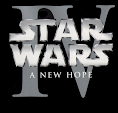
I was put off purchasing the 27-disc Skywalker Saga 4K box set released in April primarily because it looked like yet another cardboard collection of the sort that has all but killed mainstream physical media consumption, but also because my £49.99 Disney+ subscription already allows me to stream the saga’s nine episodes in 4K HDR. Stunningly crafted and über-collectible steelbooks, however, can still tempt even the most resolute of us digital media enthusiasts, and so when I received Zavvi’s Red Carpet invitation to pre-order the original Star Wars movie’s, it took only seconds for me to accept.

Unlike previous Star Wars steelbooks, this one’s appearance has been perfectly tailored to the collectors’ market. Rather than commission new artwork, one of the movie’s original posters has been repurposed for the front cover, instantly evoking that electric, pre-special edition sense of nostalgia that many of us still associate with the original Star Wars. Just as pleasingly, the iconic Obi-Wan / Darth Vader duel forms the centrefold behind the set’s three discs (one 4K, two Blu-ray), while an equally redolent shot of C-3PO and Artoo in the Tantive IV’s gleaming white corridors brings up the rear. The spine’s text lines up perfectly with those of both The Empire Strikes Back and Return of Jedi steelbooks released to date, and even The Rise of Skywalker steelbook released earlier this year - but not The Last Jedi ’s from 2018. However, all nine movies will be getting the movie-poster makeover treatment this year even if they’ve been released as steelbooks before. As well as being a sensible marketing move for Disney (who’d want to collect seven of nine movies?), this will be welcome news for those who missed out the first time around, as well as those like me who just can’t stand the annoying Blu-ray logo marring the spines of The Last Jedi and The Rise of Skywalker (which has finally been replaced by the apposite 4K Ultra-HD logo on these new 2020 releases, as pictured below).
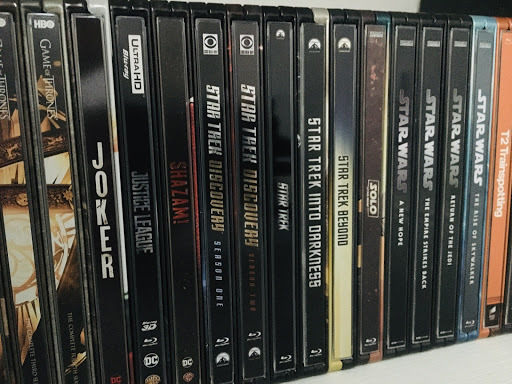
The 4K presentation of the movie is, expectedly, much better than on Disney+, though the definition of “better” is very much in the eye of the beholder. The new 4K transfer is so sharp that the grain often threatens to overwhelm, and the clarity is such that the enhanced resolution detracts from the experience as much as it embellishes it. Visionary though he was, George Lucas did not intend Star Wars’ props and sets to stand up to 2160p home-video scrutiny. The 4K disc also boasts a Dolby ATMOS soundtrack, but as a result there is not enough room for either of the pre-existing audio commentaries on it. These are included within the set, fortunately, but they are buried on the movie’s Blu-ray disc which you’d otherwise be unlikely to touch.
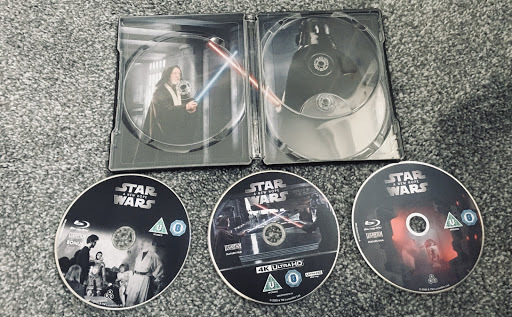
The biggest let-down with this release is its premeditated failure to be the definitive edition of what an alarming number of people now call “ A New Hope ”. Indeed, the extras package here has more in common with the vapid 2015 digital release than either of the movie’s big 21st-century physical releases, which is especially disappointing given how high-end a release this is. Whilst the set does import some of the bonus material from the 2011 Blu-ray release, and even presents it in a slightly more digestible manner, the infinitely better bonus material from the 2004 DVD release is nowhere to be seen. The omission of the flagship Empire of Dreams documentary is unforgiveable, as this is crying out for an HD or even 4K physical release, and leaving out The Characters of Star Wars; The Birth of Lightsaber; and The Force is with Them is scarcely more palatable. Even the more entertaining special features from 2011 have fallen by the wayside – the likes of Star Wars Spoofs and even the contemporary Making of Star Wars TV special from 1977 failed to make the cut this time around, whereas all the watch-once fillers like the pointlessly pictured-framed Lucasfilm Archives and even Anatomy of a Dewback made the grade. The inclusion of the latter is particularly infuriating as it only highlights the fact that the original cut of the film is both missing from this set and unlikely to be released commercially in the foreseeable future – if ever. Fortunately the priceless sixteen minutes’ worth of deleted scenes originally released in 2011 have been carried over, along with the much less welcome 2015 featurettes Conversations: Creating a Universe and Discoveries from Inside: Weapons and the First Lightsaber together with some nicely restored contemporary trailers.
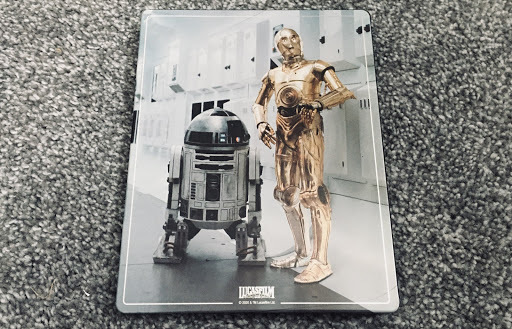
Yet despite the crippling flaws in its extras package and the inevitable exclusion of the original Star Wars cut, this release delivers full-force in the two areas that I needed it to, providing me with the highest-quality version of Star Wars: Episode IV – A New Hope [Fifth Special Edition] available and an absolutely staggering beautifully steelbook to house it in. Most people’s physical media collections may be dwindling, but targeted releases of this calibre should ensure that in time steelbooks become the movie connoisseur’s answer to vinyl.
June 8, 2020
Rants | TUI UK Retail Limited and the Great COVID-19 Refund Scandal
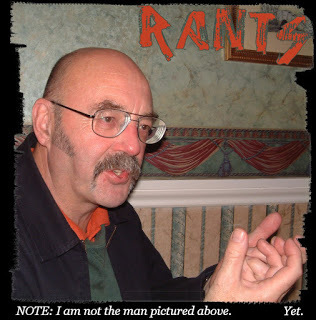 The COVID-19 pandemic has brought out the best in many individuals and organisations. Inspirational acts of bravery, kindness and charity are now commonplace. From postal and delivery workers to front-line checkout and NHS staff, people and companies have really raised their game to support the nation. Exceptional has become the new standard. Mostly.
The COVID-19 pandemic has brought out the best in many individuals and organisations. Inspirational acts of bravery, kindness and charity are now commonplace. From postal and delivery workers to front-line checkout and NHS staff, people and companies have really raised their game to support the nation. Exceptional has become the new standard. Mostly.Unfortunately, some organisations have put the numbers before the optics, allowing short-term fear to destroy their reputations in the long-term. The pandemic has effectively brought the travel industry to its knees, and I was particularly mindful of this when it came to the cancellation of my family’s trip to Disneyland which was to have taken place from 29th March 2020 to 2nd April 2020.
As we had done on previous occasions, rather than book with Disney directly, we booked our trip through TUI at their Hull Superstore. The agent that we booked with was astoundingly hard-working and helpful; she went above and beyond anything that we could have expected to accommodate our (admittedly very specific) requirements. At this point we couldn’t have held TUI in higher esteem.
Due to the outbreak of COVID-19 our trip was – understandably – cancelled. On 19th March 2020 the Hull Superstore contacted us to say that as soon as a “cancellation invoice” had been received from Disneyland, our refund would be processed. The nation was locked down a few days later and we heard no more.
Under the Package Travel, Package Holidays and Package Tour Regulations 2018 (as amended) then a customer is entitled to a refund within 14 days of the cancellation (in this case 19th March 2020) in the original payment medium. This is a statutory right. However, given the COVID-19 crisis, I waited twice this long before telephoning TUI to chase up the matter, and, when I did, as their pre-recorded greeting advised that they were working through refunds in date order, I felt it best to let them get on with it rather than slow them down by making them field another call. The quality of service that we had received in the Hull Superstore was also at the forefront of my mind and so, despite my anxieties over the money, I resolved to be patient.
As I hadn’t heard anything further by 4th May 2020, I e-mailed the Hull Superstore to chase up our refund. I received an automatic response telling me that the office was closed, and so I called the number on TUI’s website and, after holding for almost an hour, spoke to someone who gave me the devastating news that nothing at all had been done to try and process our refund as the Hull Superstore had been temporarily closed and its staff furloughed. The lady I spoke to told me that as ours was a “third-party booking”, she would have to e-mail one of her colleagues in that team to chase Disneyland for a replacement cancellation invoice, as the original would have been sent to the closed store. Upon receipt of this, she assured me, a BACS payment would be sent immediately.
Several long, frustrating telephone calls later I spoke with a member of staff who, to my relief, immediately took ownership of the matter, even providing me with her direct e-mail address. Unfortunately her helpfulness was not matched by her colleague in third-party bookings and her manager, neither of whom provided the call backs that I had been promised.
It was only following my e-mail of 27th May 2020 requesting details of TUI’s complaints procedure that a manager called me to advise that he had obtained a cancellation invoice from Disneyland. He told me that it was “a two-minute job” for the Finance Team to issue the refund, and that they had already “processed 23,000 refunds”, but he had to send a BACS form to them and it could take up to seven days for them to issue the refund. Not ideal by any means, but reasonable in the circumstances.
 Another eight days passed without the refund materialising, so I e-mailed for an update only to find that the manager had misrepresented the position to me when we spoke – the e-mail reply that I received stated that not only would it take the Finance Team an unreasonable “4-6 weeks” to issue our refund, but the manager had yet to even complete the BACS form and send it to them to start that clock ticking. Despite TUI’s admitted failure to even make a defensible attempt to process our refund until late May, they refused to swiftly remedy the situation. Were I or the firm that I work for to fail a client so badly, we would do everything in our power to remedy the situation as soon as possible, and in this case, by the manager’s own admission, the resolution would take someone all of two minutes to execute!
Another eight days passed without the refund materialising, so I e-mailed for an update only to find that the manager had misrepresented the position to me when we spoke – the e-mail reply that I received stated that not only would it take the Finance Team an unreasonable “4-6 weeks” to issue our refund, but the manager had yet to even complete the BACS form and send it to them to start that clock ticking. Despite TUI’s admitted failure to even make a defensible attempt to process our refund until late May, they refused to swiftly remedy the situation. Were I or the firm that I work for to fail a client so badly, we would do everything in our power to remedy the situation as soon as possible, and in this case, by the manager’s own admission, the resolution would take someone all of two minutes to execute!Accordingly, a formal complaint has been made to TUI along with another to ABTA. Trading Standards have also been alerted to the situation.
Were I to hold client money for 82 days following the completion or cancellation of a matter, I’d probably end up being struck off and my principals would face possibly an even bleaker fate. Surely it is now the time for the government to look at imposing such strict regulation on the travel sector to prevent the sort of business practices that I have personally experienced from TUI, and that it seems many others are experiencing too – some of them in extreme financial hardship due to the COVID-19 crisis. Of course, our government is failing us at every turn in matters of life and death, and so it’s perhaps unsurprising that it is also failing us on comparatively paltry matters.
If, like us, you were amongst the first to be affected but have not yet been refunded, then my advice is do not be patient - you will only be punished for it by being put to the back of the queue , if you are lucky enough to be in it all. The more noise we all make, the sooner we will have our hard-earned cash back.
Once you have their money, you never give it back.
- The First Ferengi Rule of Acquisition
Update - 25th June 2020
Neither TUI nor ABTA responded to me within the promised timescales (14 days for TUI’s Complaints Team, 28 days for ABTA) and so I wrote to our local MP. Sadly it’s David Davis, so no luck there either – just an automated response.
Fortunately I’m a practising lawyer – albeit a furloughed one – and have no qualms about pursuing the matter through the small claims court as a litigant in person if need be. However, doing so, particularly in the current crisis, is likely to take even longer than the six weeks from whenever the manager I spoke to deigns to complete a BACS form, to say nothing of the court fees involved, and so for now all I can do is prepare a letter of claim in accordance with the Pre-action Protocol for Resolution of Package Travel Claims and ask TUI to nominate solicitors to accept service of proceedings in the (likely) event that my letter of claim goes unacknowledged within the prescribed period.
Final Update - 1st July 2020
The refund arrived in my bank account this morning (1st July 2020, 104 days on from the cancellation of our holiday and, suspiciously, just outside TUI’s painful second quarter) without any word at all from TUI, let alone a word of apology. I don’t plan to issue court proceedings to claim the 63p interest that I’ve calculated we’re owed, but, needless to say, TUI have lost my custom - and hopefully anyone else’s who reads this post or speaks to me about them.
E.G. Wolverson's Blog
- E.G. Wolverson's profile
- 52 followers



